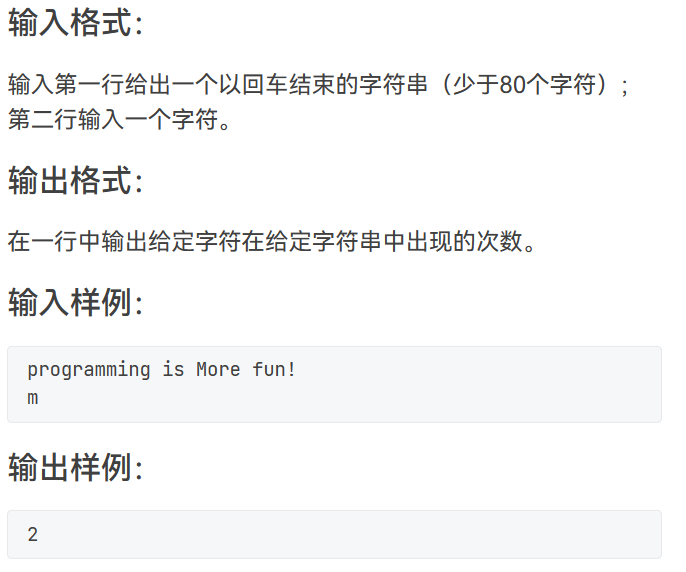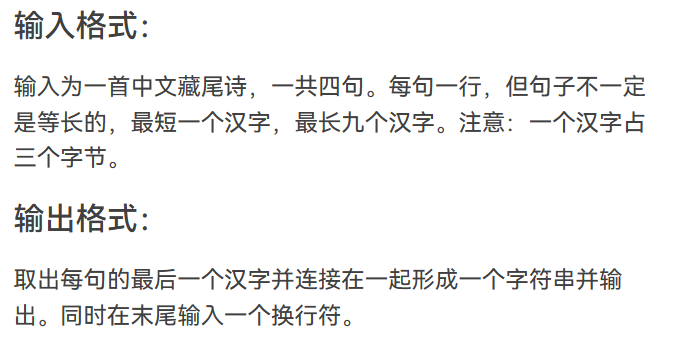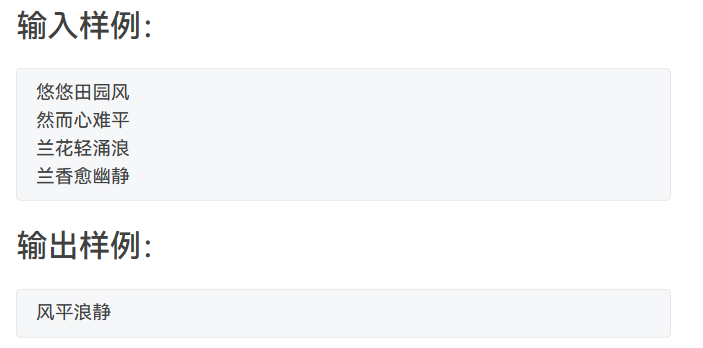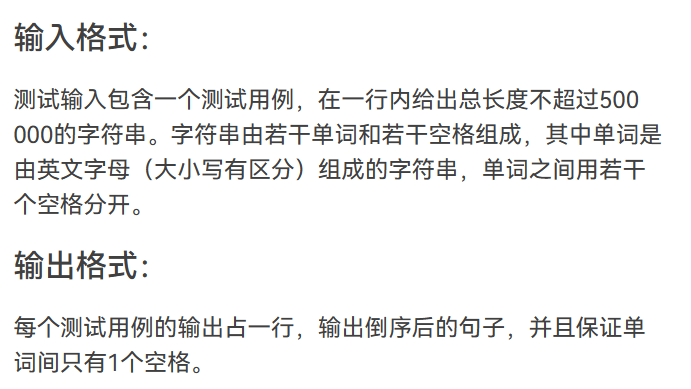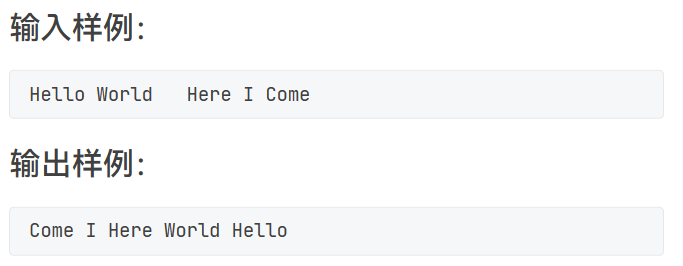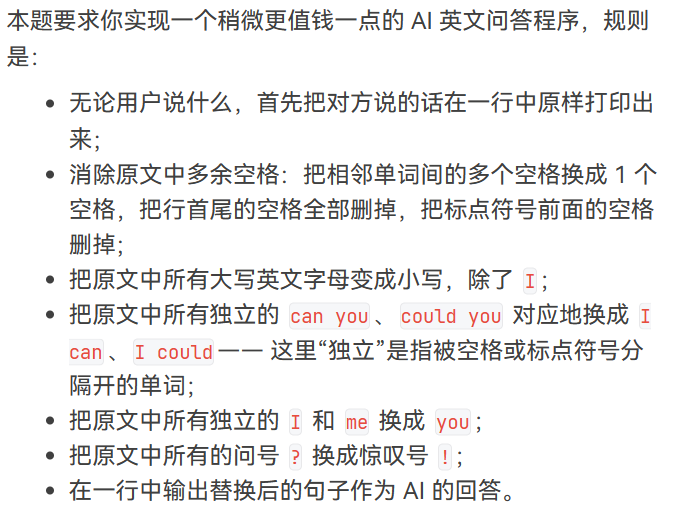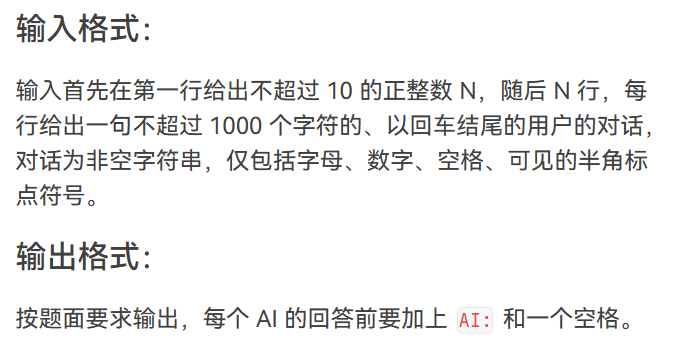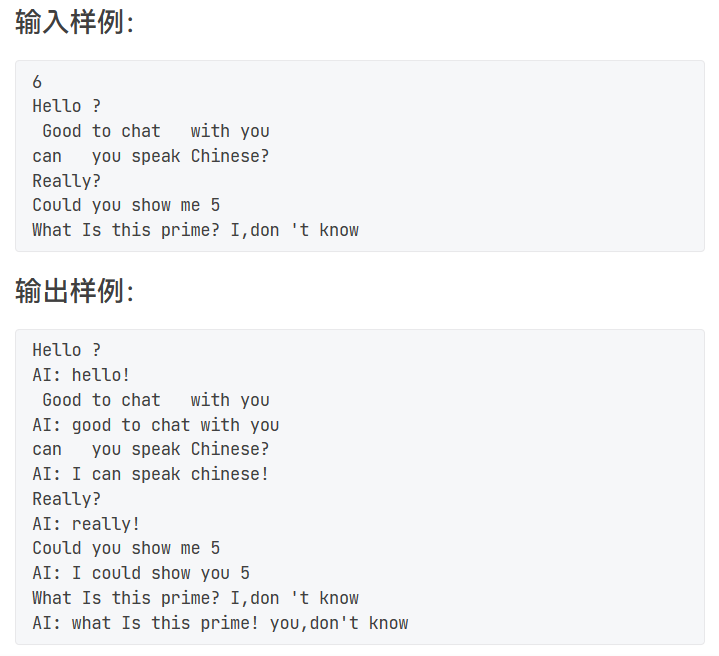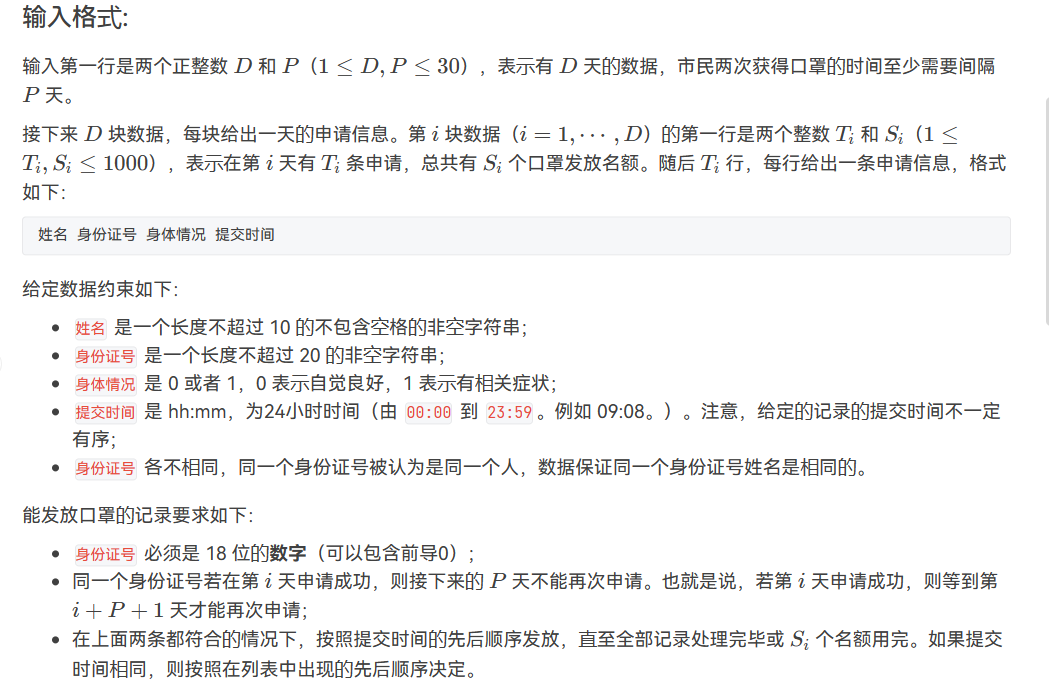记录天梯赛训练碰到的问题
字符串
输入空格
C++中
scanf()函数读字符,空格成功读入,碰到回车,tab,空格结束
cin读string,空格全部跳过,最后碰到回车结束
输入样例:
programming is More fun!
m
输出样例:
2
最后一个测试点只有一个空格,所以我一开始用cin函数输入失败了
1 2 3 4 5 6 7 8 9 10 11 12 13 14 15 16 17 18 19 20 21 22 23 24 25 26 27 28 29 30 31 32 #include <iostream> using namespace std;const int defaultSize = 1000 ;int lst[130 ] = { 0 };char result;void Init () char temp = '0' ; while (1 ) { scanf ("%c" , &temp); if (temp == '\n' ) { break ; } lst[temp]++; } scanf ("%c" , &result); } int main () Init (); cout << lst[(int )result]; }
最后一个测试点是只有一个空格,参考PTA 实验7-3-8
统计字符出现次数
我用的是输入一个一个字符的方法,也可以直接读取这个字符串再处理
C++中如果要输入带空格的字符串,可以用cin.getline()函数,也可以用<stdio.h>中gets()函数
cin.getline(char* s, int count, char end)
s为字符数组,count为读取个数,end为结束字符,如果不写end则碰到回车结束,所以可以用这个函数读带空格的字符串
读入的字符串结尾字符为'\0'
1 2 3 char s1[1000 ];cin.getline (s1, 1000 ); cout << s1;
也可以带<string>头文件,这样可以用string自带的函数,比如length(),find()等
getline(cin, string str)
第一个参数是cin,第二个参数直接带string类型就好
1 2 3 string str; getline (cin,str);cout << str;
参考ACM小练习之字符串的处理
汉字字符串
UTF-8,一个汉字占2个字节
1 2 string a = "测试abc" ; cout << a.length ();
输出为7
1 2 3 4 5 6 string a = "测试abc" ; char c[3 ];c[0 ] = a[0 ]; c[1 ] = a[1 ]; c[2 ] = '\0' ; cout << c;
输出为测
这样就有了截取字符串中汉字的方法,即用一个长度为3的char数组,前2个元素存对应汉字对应字节,最后一个元素存'\0',可以保证字符串正常输出
但是把这样的解决方法提交到PTA中,发现失败了
PTA中提示说一个汉字3个字节,把字符数组长度重新调整为4,一个汉字的3个字节重新交一下,发现成功过了全部测试点,挺怪的
输入样例:
悠悠田园风 然而心难平 兰花轻涌浪 兰香愈幽静
输出样例:
风平浪静
以下是成功通过PTA的代码,可能因为编码方式不同,本机跑一个汉字2个字节
1 2 3 4 5 6 7 8 9 10 11 12 13 14 15 16 17 18 19 20 21 22 23 24 25 26 27 28 29 30 31 32 33 34 35 36 37 38 39 40 41 42 43 44 45 46 47 48 49 50 #include <iostream> using namespace std;const int defaultSize = 1000 ;string lst[5 ]; void Init () for (int i = 0 ; i < 4 ; i++) { cin >> lst[i]; } } void Print_PTA () char result[4 ]; result[3 ] = '\0' ; for (int i = 0 ; i < 4 ; i++) { int len = lst[i].length (); result[2 ] = lst[i][len - 1 ]; result[1 ] = lst[i][len - 2 ]; result[0 ] = lst[i][len - 3 ]; cout << result; } cout << endl; } void Print () char result[3 ]; result[2 ] = '\0' ; for (int i = 0 ; i < 4 ; i++) { int len = lst[i].length (); result[1 ] = lst[i][len - 1 ]; result[0 ] = lst[i][len - 2 ]; cout << result; } cout << endl; } int main () Init (); Print_PTA (); }
参考藏尾诗-PTA
删除字符串中的字串
又是需要输入空格的字符串,不能直接cin
一开始我的做法是利用cin.getline()函数得到了一个char类型的数组,然后自己写char数组的删除函数,相等判断函数
这明显就是重复造轮子的行为
1 2 3 4 5 6 7 8 9 10 11 12 13 14 15 16 17 18 19 20 21 22 23 24 25 26 27 28 29 30 31 32 33 34 35 36 37 38 39 40 41 42 43 44 45 46 47 48 49 50 51 52 53 54 55 56 const int defaultSize = 1000 ;char s1[defaultSize], s2[defaultSize];int len1 = 0 , len2 = 0 ;void Init () cin.getline (s1, defaultSize); cin.getline (s2, defaultSize); for (int i = 0 ; s1[i] != '\0' ; i++) { len1++; } for (int i = 0 ; s2[i] != '\0' ; i++) { len2++; } } bool Compare (char * str1, char * str2, int index) int it = 0 ; for (int i = index; str1[i] != '\0' && str2[it] != '\0' ; i++) { if (str1[i] != str2[it]) { return 0 ; } it++; } return 1 ; } void Remove (char * str, int len, int index) for (int i = index; str[i] != '\0' ; i++) { str[i] = str[i + len]; } } void Result () for (int i = 0 ; i < len1; i++) { if (s1[i] == s2[0 ]) { if (Compare (s1, s2, i)) { Remove (s1, len2, i); len1 -= len2; i = -1 ; } } } }
但是用cin.getline()只能得到char[],没有string那么方便,还多加了很多时间用来造轮子和debug
虽然造轮子也是程序的浪漫,但是这无疑会消耗许多时间
这样的情况可以包含<string>头文件,里面有对getline()的重载,就可以直接输入带空格的字符串,并且还能利用string类型自带的函数,如erase(), find(), length()等可以节约许多时间
string的find()函数可以找一个指定字符,也可以找一个字符串,如果没找到返回值就是string::npos,通常是无符号int或无符号long的最大取值,这个值强制类型转换成int就是-1
1 2 3 4 5 6 7 8 9 10 11 void useStringtoSolve () string str1, str2; getline (cin, str1); getline (cin, str2); while (str1.find (str2) != string::npos) { str1.erase (str1.find (str2), str2.length ()); } cout << str1; }
过了的完整代码如下,包括自己造轮子的写法在内,两种方法都能成功过这个题
1 2 3 4 5 6 7 8 9 10 11 12 13 14 15 16 17 18 19 20 21 22 23 24 25 26 27 28 29 30 31 32 33 34 35 36 37 38 39 40 41 42 43 44 45 46 47 48 49 50 51 52 53 54 55 56 57 58 59 60 61 62 63 64 65 66 67 68 69 70 71 72 73 74 75 76 77 78 79 80 81 82 83 84 85 86 87 88 89 90 91 92 93 94 95 96 97 98 #include <iostream> #include <string> using namespace std;const int defaultSize = 1000 ;char s1[defaultSize], s2[defaultSize];int len1 = 0 , len2 = 0 ;void Init () cin.getline (s1, defaultSize); cin.getline (s2, defaultSize); for (int i = 0 ; s1[i] != '\0' ; i++) { len1++; } for (int i = 0 ; s2[i] != '\0' ; i++) { len2++; } } void Print () for (int i = 0 ; i < len1; i++) { cout << s1[i]; } cout << endl; } bool Compare (char * str1, char * str2, int index) int it = 0 ; for (int i = index; str1[i] != '\0' && str2[it] != '\0' ; i++) { if (str1[i] != str2[it]) { return 0 ; } it++; } return 1 ; } void Remove (char * str, int len, int index) for (int i = index; str[i] != '\0' ; i++) { str[i] = str[i + len]; } } void Result () for (int i = 0 ; i < len1; i++) { if (s1[i] == s2[0 ]) { if (Compare (s1, s2, i)) { Remove (s1, len2, i); len1 -= len2; i = -1 ; } } } } void useCharArrtoSolve () Init (); Result (); Print (); } void useStringtoSolve () string str1, str2; getline (cin, str1); getline (cin, str2); while (str1.find (str2) != string::npos) { str1.erase (str1.find (str2), str2.length ()); } cout << str1; } int main () useStringtoSolve (); }
参考字符串字串删除
需要注意的是,getline(cin, str);这个函数是直接从cin缓冲区中读的
也就是说,如果测试样例如图
想得到I love GPLT这个字符串,就得调用2次getline(cin, str);因为第一次调用得到的是空字符串
即使前面已经用cin获取了15 _这两个输入也不行,一定要调用两次才能得到所需字符串
cin的返回值
先放题
输入样例:
Hello World Here I Come
输出样例:
Come I Here World Hello
想到可以直接用cin函数跳过空格,然后空格留在缓冲区中,用一个getchar()可以把空格读出来
cin同时也会遇到回车结束,用一个getchar()可以把回车读出来,由此可以判断回车结束
但是这样正常结束的前提是像示例输入一样,一个单词几个空格,结尾必须是单词
如果结尾是空格,即测试点1,输入一个词,末尾有空格,就会一直卡在while循环的cin >> lst[i];步骤,不能正常结束,于是超时
同理,测试点3,只输入空格,也会一直卡在cin >> lst[i];不能正常结束
1 2 3 4 5 6 7 8 9 10 11 12 13 14 15 16 17 18 19 20 21 22 23 24 void Init_char () char t = 't' ; int i = 0 ; while (t != 10 ) { cin >> lst[i]; i++; N++; t = getchar (); } for (i = N - 1 ; i > 0 ; i--) { cout << lst[i] << " " ; } if (N > 0 ) { cout << lst[0 ] << endl; } else { return ; } }
如果把cin函数写在while循环判断条件里,就可以利用读到文件尾的返回值结束循环
OJ系统测试点都是读文件,所以可以利用这一特性来完成读空格和读回车的判断
如果把cin写在while的判断条件里,在Windows本地跑,需要手动输入ctrl+z模拟文件的EOF,才能正常结束
1 2 3 4 5 while (cin >> lst[i]){ i++; N++; }
完整代码
1 2 3 4 5 6 7 8 9 10 11 12 13 14 15 16 17 18 19 20 21 22 23 24 25 26 27 28 29 30 31 32 33 34 35 36 37 38 39 40 41 42 43 44 45 46 47 48 49 50 51 52 53 54 #include <iostream> using namespace std;const int defaultSize = 500010 ;string lst[defaultSize]; int N = 0 ;void Init () int i = 0 ; while (cin >> lst[i]) { i++; N++; } for (i = N - 1 ; i > 0 ; i--) { cout << lst[i] << " " ; } cout << lst[0 ] << endl; } void Init_char_fail () char t = 't' ; int i = 0 ; while (t != 10 ) { cin >> lst[i]; i++; N++; t = getchar (); } for (i = N - 1 ; i > 0 ; i--) { cout << lst[i] << " " ; } if (N > 0 ) { cout << lst[0 ] << endl; } else { return ; } } int main () Init (); }
参考说反话-加强版
正则表达式
先放题
输入样例:
1 2 3 4 5 6 7 6 Hello ? Good to chat with you can you speak Chinese? Really? Could you show me 5 What Is this prime? I,don 't know
输出样例:
1 2 3 4 5 6 7 8 9 10 11 12 Hello ? AI: hello! Good to chat with you AI: good to chat with you can you speak Chinese? AI: I can speak chinese! Really? AI: really! Could you show me 5 AI: I could show you 5 What Is this prime? I,don 't know AI: what Is this prime! you,don't know
此题我认为最难的部分在于替换这部分,空格的处理和大小写替换很容易实现
尝试写了判断单词分隔的问题,写了很久还是有问题
去网上找解决方案,查到了用正则表达式写的方法
正则表达式 regex 要包含<regex>头文件,只有在C++
11以上版本才有这个,我拿dev-C++跑就报错,是因为C++版本不够
我唯一不会实现的功能就是Replace(str)函数,所以参考查找的代码看一下怎么替换单词:
1 2 3 4 5 6 s = regex_replace (s, regex (R"(\bcan you\b)" ), "_I can" ); s = regex_replace (s, regex (R"(\bcould you\b)" ), "_I could" ); s = regex_replace (s, regex (R"(\bI\b)" ), "you" ); s = regex_replace (s, regex (R"(\bme\b)" ), "you" ); s = regex_replace (s, regex (R"(\?)" ), "!" ); s = regex_replace (s, regex (R"(\b_I\b)" ), "I" );
用到了regex_replace(string str1, regex reg, string str2)函数,其返回值是一个修改好的字符串
修改的方式是:将str1中所有符合regex的内容替换为str2
中间regex类型的reg是正则表达式对象
注意,创建正则表达式对象的时候,要考虑转义字符,\\算作一个\
如下图代码所示
1 2 3 4 5 6 7 string str; getline (cin, str);regex reg ("(\\bcan you\\b)" ) ; str = regex_replace (str, reg, "_I can" ); str = regex_replace (str, regex (R"(\b_I\b)" ), "I" ); cout << str;
输入can you do it , 输出I can do it
但是每次要打两个\明显很麻烦,所以就有了示例代码的写法,用一个R表示里面的内容是纯字符串 ,即不再需要增加\来转义特殊字符
即
1 2 regex reg ("(\\bcan you\\b)" ) ;str = regex_replace (str, reg, "_I can" );
和
1 str = regex_replace (str, regex (R"(\bcan you\b)" ), "_I can" );
功能完全相同
而中间用到的\b,就是用来判断单词边界的,例如正则表达式\bsome\b在字符串"some games"中能找到匹配,在字符串"something good"中却找不到
原码中还要注意处理大写I,即替换原句中me, I为you和替换原句can you, could you为I can, I could的顺序
源码替换can you的时候,先换的_I can,最后再把_I换成了I,完美解决问题
最后源码如下
1 2 3 4 5 6 7 8 9 10 11 12 13 14 15 16 17 18 19 20 21 22 23 24 25 26 27 28 29 30 31 32 33 34 35 36 37 38 39 40 41 42 43 44 45 46 47 48 49 50 51 52 53 54 55 56 57 58 59 60 61 62 63 64 65 66 67 68 69 70 71 72 73 74 75 76 77 78 79 #include <iostream> #include <string> #include <regex> using namespace std;const int defaultSize = 1010 ;int N;void Space (string& str) for (int i = 0 ; i < str.length (); i++) { if (i == 0 && str[i] == ' ' || str[i] == ' ' && str[i + 1 ] == ' ' ) { str.erase (i, 1 ); i--; continue ; } if (str[i] == ' ' && (str[i + 1 ] >= 33 && str[i + 1 ] <= 47 || str[i + 1 ] >= 58 && str[i + 1 ] <= 64 || str[i + 1 ] >= 91 && str[i + 1 ] <= 96 || str[i + 1 ] >= 123 && str[i + 1 ] <= 126 )) { str.erase (i, 1 ); i--; continue ; } } while (str[str.length () - 1 ] == ' ' ) { str.erase (str.length () - 1 , 1 ); } } void Replace (string& str) for (int i = 0 ; i < str.length (); i++) { if (str[i] == '?' ) { str[i] = '!' ; } if (str[i] >= 'A' && str[i] <= 'Z' && str[i] != 'I' ) { str[i] += 'a' - 'A' ; } } str = regex_replace (str, regex (R"(\bcan you\b)" ), "_I can" ); str = regex_replace (str, regex (R"(\bcould you\b)" ), "_I could" ); str = regex_replace (str, regex (R"(\bI\b)" ), "you" ); str = regex_replace (str, regex (R"(\bme\b)" ), "you" ); str = regex_replace (str, regex (R"(\b_I\b)" ), "I" ); } void Solve (string& str) Space (str); Replace (str); } void Result () cin >> N; string Question; getline (cin, Question); for (int i = 0 ; i < N; i++) { getline (cin, Question); cout << Question << endl; Solve (Question); cout << "AI: " << Question << endl; } } int main () Result (); }
其实也可以用正则表达式替换空格的,但是替换空格的函数我手动实现了,具体实现过程可以看参照的源码:
1 2 3 4 5 6 7 8 9 s = regex_replace (s, regex (R"(\s+)" ), " " ); if (s.front () == ' ' ) s.erase (s.begin ());if (s.back () == ' ' ) s.pop_back ();s = regex_replace (s, regex (R"( !)" ), "!" ); s = regex_replace (s, regex (R"( ,)" ), "," ); s = regex_replace (s, regex (R"( \.)" ), "." ); s = regex_replace (s, regex (R"( \?)" ), "?" ); s = regex_replace (s, regex (R"( ')" ), "'" );
参考PTA
估值一亿的AI核心代码
参考C++正则表达式简单总结
利用map绑定string和int
先放题
处理这道题时碰到一个难以解决的问题:怎么让string类型的身份证号与int类型的申请时间绑定?
因为代码能力不足,所以想手动写一个哈希函数的想法失败了,于是上网找了相应解决方案
找到了C++的map容器,可以完美解决这个问题,又一次体会到了跳过重复造轮子过程的爽快感
map容器可以绑定两个一对一的数据,第一个数据为键 ,第二个数据为值
键不能重复,也不能修改,值可以随便修改
这就完美解决了身份证和时间的对应关系:身份证号独一无二,而申请时间可以随意修改
但是map容器存放顺序不是按输入顺序来的,而最后的输出需要按输入顺序,这个就很麻烦了
来看一下map容器的用法:
要包含<map>头文件
声明方法:map<string, int> IDtime;
map容器中存的键值对,本质都是 pair 类模板创建的 pair
对象,可以用{}简写,但是这里只记录map容器的用法
map容器实现了对[ ]运算符的重载,插入元素,查找元素,更新元素都可以用[ ]运算符实现
例如Mymap["WHITE ALBUM 2"] = 1;
如果Mymap里一开始没有键为"WHITE ALBUM 2"的元素,那就将这条元素插入容器中;如果有键为"WHITE ALBUM 2"的元素,那么就可以更新对应的值,可以利用这点很方便地进行插入和查找值
find()函数,参数带入键,如果不能找到键则返回Mymap.end()
插入的元素会按键的顺序从小到大存放在容器中,并不是按插入顺序存放 的
用for循环迭代元素,先声明一个迭代器map<string,int>::iterator it;但是可以用auto来简写;结束条件为it != Mymap.end(),简写后的代码为for (auto it = Mymap.begin(); it != Mymap.end(); it++)
it的first元素为键,second元素为值
删除元素,调用erase()函数,可以指定键进行删除,也可以用find()函数返回一个迭代器,再进行删除
示例用法
1 2 3 4 5 6 7 8 9 10 11 12 13 14 15 16 17 18 19 20 21 22 23 24 25 26 27 28 29 30 31 int main () map<string, int > Mymap; Mymap["WHITE ALBUM 2" ] = 1 ; Mymap["サクラノ詩" ] = 1 ; Mymap["STEINS;GATE" ] = 2 ; Mymap["Ever17" ] = 3 ; cout << Mymap["WHITE ALBUM 2" ] << endl; Mymap["WHITE ALBUM 2" ] = 0 ; cout << Mymap["WHITE ALBUM 2" ] << endl; for (auto it = Mymap.begin (); it != Mymap.end (); it++) { cout << it->first << " " << it->second << endl; } Mymap.erase ("Ever17" ); cout << endl; for (auto it = Mymap.begin (); it != Mymap.end (); it++) { cout << it->first << " " << it->second << endl; } }
然后就是排序函数,sort()函数要包含<algorithm>头文件
排序函数要写比较函数,返回值为bool
调用如下:
1 2 3 4 5 6 7 8 9 10 11 12 13 14 15 16 17 18 19 20 21 22 23 24 25 26 27 28 29 30 31 const int defaultSize = 100 ;struct info { int time; int idx; }; bool cmp (info a, info b) if (a.time == b.time) { return a.idx < b.idx; } return a.time < b.time; } int main () info lst[defaultSize]; for (int i = 0 ; i < defaultSize; i++) { lst[i].time = rand () % 100 ; lst[i].idx = i; } sort (lst, lst + defaultSize, cmp); for (int i = 0 ; i < defaultSize; i++) { cout << lst[i].time << " " << lst[i].idx << endl; } }
输出为先按time从小到大排序,如果相同按idx由小到大排序
有了map和排序,就可以解决这个题了
首先是时间的换算,把输入的小时乘60再加分钟,可以得到一个时间,cmp()函数就用时间和输入顺序判断
注意输出时解决顺序问题,我的代码因为这个问题卡了4,5测试点,没有完全正确
参考map 详解
(C++)
参考【PTA-训练day23】L2-034
口罩发放
凯撒密码
很基础的问题了,但还是有要注意的地方
向左位移就是输入负值,但是这个负值可能非常大
所以正确的算法是先将位移值余26,如果得到小于0的数,这时的值就换成26 + N,这样就可以解决问题了
1 2 3 4 5 6 7 8 9 10 11 12 13 14 15 16 17 18 19 20 21 22 23 24 25 26 27 28 29 30 31 32 33 34 35 36 37 38 #include <iostream> #include <string> using namespace std;string str; long N;void Init () getline (cin, str); cin >> N; N = N % 26 ; if (N < 0 ) { N = 26 + N; } for (int i = 0 ; i < str.length (); i++) { if (str[i] >= 'A' && str[i] <= 'Z' ) { str[i] = (str[i] - 'A' + N) % 26 + 'A' ; } else if (str[i] >= 'a' && str[i] <= 'z' ) { str[i] = (str[i] - 'a' + N) % 26 + 'a' ; } } cout << str << endl; } int main () Init (); return 0 ; }
字符串总结
输入带字符的字符串:
用cin.getline(),得到一个char数组
包含<string>头文件,用getline(cin, string str)可以得到一个完整字符串,但注意getline()函数读相应位置的字符串就要对应调用多少次
一个汉字的UTF-8编码占2个字节,如果要显示单个汉字,就需要建立一个char数组,长度为3,下标为2的存'\0',前面2个存对应的字节就好,输出就直接用cout,这样就可以显示一个单独的汉字
删除字符串字串,用string自带的函数find()和erase(),find函数没找到对应字串就会返回string::npos,用于循环结束;找到了就会返回对应位置的下标,可以传给erase()函数,并指定字串的长度
while (cin >> lst[i])问题,本地运行要手动ctrl+z
正则表达式,包含<regex>头文件,用\b判断单词分隔,用R指明纯字符串,不考虑\转换符
替换的时候用regex_replace(string str1, regex reg, string str2)函数
凯撒密码注意左移情况,先余26,若小于0再加26
map容器和排序函数
map多用[ ]的重载,不用考虑重复键情况,很好用
循环遍历可以简写为for (auto it = Mymap.begin(); it != Mymap.end(); it++),这个auto很好用
排序函数手动实现bool cmp()函数,return期望的顺序,注意return的表达式不能带等号
考虑顺序问题时可以多一个idx变量,用于cmp()的比较
参考资料
PTA 实验7-3-8
统计字符出现次数
ACM小练习之字符串的处理
藏尾诗-PTA
字符串字串删除
说反话-加强版
PTA
估值一亿的AI核心代码
C++正则表达式简单总结
map
详解 (C++)
【PTA-训练day23】L2-034
口罩发放
